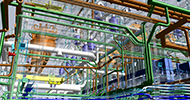Root cause analysis is a methodology that involves understanding how and why problems occur during the manufacturing process. By uncovering the underlying factors that cause equipment failure, defective products and performance issues, companies can resolve them once and for all so they don’t continue to interfere with their processes and impede their ability to succeed.
Why is root cause analysis important?
Without root cause analysis, manufacturers have a tendency to leap very quickly from problem to solution. They don’t take the time to collect data, analyze the facts and create an action plan that targets the underlying issues and not just the symptoms. By slowing downand performing root cause analysis first, companies can avoid short-term solutions and the long-term problems that accompany them.
How is root cause analysis performed?
To perform root cause analysis, the problem must first be defined. Organizations should gather the facts via reports, interviews and data sets collected on site, and draft the problem based on the information found in these documents. Also included in this definitionshould be the specific consequences of the problem. This definition will serve as the starting point for analysis, and will likely change as the process unfolds and more information is revealed.
Once the problem is thoroughly defined, the manufacturer needs to understand why it happened. For example, let’s say the problem is that a certain piece of equipment stopped working properly, which led to defective and unsafe products being delivered to consumers. Continue to ask “why” until the root cause is found. For example, why did the pump feed stop pumping? Because of broken coupling. Why was there broken coupling? Because the motor bearing was seized. Why was the motor bearing seized? Because the bearing race collapsed. Why did the bearing race collapse? Because of operator fatigue.
With operator fatigue, we have arrived at the root cause of the problem: the underlying factor that must be addressed in order to prevent a recurrence of the issue. In this case, the company could take steps to improve ergonomics on the plant floor or implement stricter break policies to ensure that employees are alert enough to operate the equipment properly,thus avoiding equipment failure, defects and other issues moving forward.














